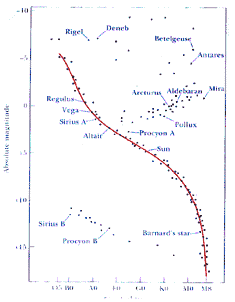 A
H-R diagram (the red line represents the Main Sequence Stars).
A
H-R diagram (the red line represents the Main Sequence Stars).Stellar Evolution
:
The Life and Death of Our Luminous Neighbors
by Arthur Holland and Mark Williams
Introduction and Why You Should Care
Observations of the stars with calculations of stellar models have give astronomers a comprehension of stellar evolution. Stellar evolution is the process in which the forces of pressure (gravity) alter the star. With these forces acting upon stars, their characteristics change dramatically over the period of their existence.
Stellar evolution is inevitable as stars deplete their initial fuel sources. The search for new fuel sources affects the properties of stars as they evolve. This evolution is a process that consists of many different stages with fuel consumption as the dominant life cycles of an evolving star.
Stellar evolution, in the form of these fuel consumption stages and their finality, is important because it is responsible for the production of most of the elements (all elements after H and He). Moreover, stages in the life cycle of stars are a vital part in the formation of galaxies, new stars and planetary systems.
Time scales of Stellar Fuel Consumption
The time scales of stellar evolution depend on the mass of the star. The rule governing stellar evolution is the more mass present, the faster the evolution for the star through the fuel consumption stages. Another property directly linked to the mass and evolution of a star is its luminosity.
The mass-luminosity relation demonstrates that the main sequence on an H-R diagram (a chart plotting the the luminosities of stars against their surface temperatures) is a progression in mass as well as in luminosity and surface temperature (Kaufmann,1991, pg. 356). The Hertzsprung- Russell diagram is two possible plots of spectral types dependent on absolute magnitude when compared to temperature and luminosity.
These H-R diagrams allow astronomers to conceptualize visually the mass-luminosity relationship as it pertains to the fuel consumption evolution of stars. The H-R diagram allows astronomers to plot visually the different stages in the evolving life cycle of stars.
 A
H-R diagram (the red line represents the Main Sequence Stars).
A
H-R diagram (the red line represents the Main Sequence Stars).
Stages in the Life of an Evolving Star
Welcome to the life of a new born star. Main sequence stars are a range of stars based on size and surface temperature starting from the hot, bright, bluish stars in the upper left corner of a H-R diagram to the cool , dim, reddish stars in teh lower right corner of the diagram. Life for new stars begins in the Main Sequence. These mature stars undergo a remarkable transformation after they consume all the hydrogen in their core. With the hydrogen consumed, stars leave the main sequence and expand to form red giants. With this new stage, the fusion of helium begins to form heavier elements like Oxygen and Carbon. This process of expansion- collapse-expansion of stars forms the light elements present in the universe (up to Fe).
Life in the Suburbs : a Main Sequence Star. Main sequence stars are stars whoís luminosity and surface temperature place it in the ëmain sequenceí of a Hertzsprung- Russell diagram.
A fundamental property of all main sequence stars is thermal equilibrium. Thermal equilibrium is the liberation of energy from the interior of the star balanced by the energy released at the surface of the star. The energy released by a main sequence star is produced by hydrogen burning in its core (the fusion of 4H into 4He).
Another fundamental property of a main sequence star evolution is hydrostatic equilibrium. Hydrostatic equilibrium reflects the required pressure in the core of a star to support the weight of the outer plasma layers. The heat produced from hydrogen in the core burning supports this outward pressure upon the outer plasma layers.
As a main sequence star depletes the supply of hydrogen in the core, thermal equilibrium unbalances and the pressure in the starís core lessens. Thermal equilibrium unbalances because the fusion of four hydrogen atoms into one helium atom decreases the number of particles present in the starís core. The star beings to collapse inward because the fewer particles cannot maintain the pressure needed to support the starís outer layers.
Without the necessary pressure, the starís core contracts slightly under the weight of its outer layers. This collapse increases the pressure and temperature of the core causing the luminosity of the star's surface to increase. This increase in pressure on the layers just outside the core raises their temperature to the necessary point in which the outer layers of hydrogen begin fusion.
This occurrence of hydrogen fusion in the outer layers of a collapsing star is called shell hydrogen burning. Shell hydrogen burning allows the star to remain in the main sequence for another few million years. Despite this struggle to remain on the main sequence, the supply of hydrogen for fusion into helium in a starís inner most layers depletes, which takes the star from the main sequence and to the next step of solar fuel consumption.
The next stage of solar fuel consumption starts when hydrogen burning in the core ceases and ignites hydrogen burning in the star's outer layers. When hydrogen burning ceases in the starís core, it begins to collapse again. At this point, the star converts gravitational energy into thermal energy because it must maintain thermal equilibrium.
Stars sustain thermal equilibrium within their interiors through the ignition of helium burning. The collapse of the outer hydrogen burning shell upon the core raises the temperature and pressure in the core and begins helium burning. Because the temperature and energy needed to ignite helium fusion is greater than that of hydrogen, the energy released by helium fusion in the starís core is greater than needed to support the weight of the outer layer.
This excess energy expands the starís outer layers beyond its previous radius and starís volume increases. A star going through this stage of fuel consumption (collapse and expansion) is a Red Giant. The following diagram shows the dramatic expansion of a main sequence star as it begins helium fusion.
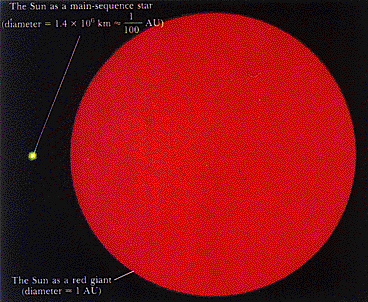 Our
Sun today compared to its future Red Giant self
Our
Sun today compared to its future Red Giant self
1 AU is approximately 150 million kilometers or the distance from the sun to the Earth's orbit
The Life of a Red Giant : A Star in Old Age. In the final states of hydrogen fusion the hydrogen burning shell adds to the mass of the starís helium core. This added mass and pressure increases the starís temperature. Temperature within the core of stars greater than three solar masses soon exceeds the 100 million Kelvin degrees barrier, at which it reaches the temperature needed for the onset of helium fusion.
Core helium burning reestablishes the thermal equilibrium needed to support the starís outer layers preventing further gravitational contraction. With gravitational contraction halted, the heat and energy from the core helium burning again begins the expansion of the star's outer layers. The method by which a star begins core helium burning depends upon the mass of the star.
In stars below three solar masses (low-mass stars), helium fusion begins in a more spectacular manner. Helium burning begins explosively and abruptly. This process of quick ignition of helium fusion is a helium flash. The universe does not limit helium flash to low-mass stars; Helium is present in red giants and red supergiants as well.
Red supergiants and red giants share the same physical characteristics and properties, with size and luminosity the only major difference between them. To understand this size difference we use our sun as a reference point. Red giants have solar radii up to 10 to 100 times larger than our sun, while supergiants boast a solar radii 1000 times larger than that of our sun.
A Low-Mass Starsí last gasp. Stellar evolution can end in several ways. After a long life, an aging star completes its red supergiant stage of evolution and shell helium burning begins. Since this shell of helium burning is thin, the star becomes unstable. This instability in the aging star increases the temperature and energy within the star, which thickens the shell of burning helium surrounding the helium-depleted core.
The shell of burning helium thickens until it can support the pressures of the starís outer layers. As the shell helium burning increases the temperature and energy of the surrounding outer layers of the star, it ignites the outer hydrogen shell into fusion through thermonuclear reactions. This process of outer hydrogen shell fusion is a thermal pulse.
During thermal pulses, the starís luminosity increases by a factor of ten. This final expansion and ignition of outer layers is the starís final moments before death overcomes the star. In its final moments, a star ejects its outer layers emitting ultraviolet radiation. This emission of ultraviolet radiation ionizes the ejected gases, giving them a glow known as a planetary nebula.
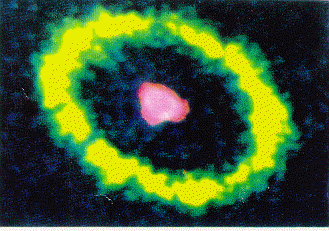 A
planetary nebula, the death of a low mass star
A
planetary nebula, the death of a low mass star
The ejection of stellar remnants is the low-mass starís supernova. On Earth, we measure the effects of this supernova in the increased luminosity. After a low-mass starís death (supernova), it often leaves behind material that forms new stellar bodies.
This is the end of stars with low masses (less than four solar masses) because they cannot reach the appropriate t temperature levels to begin the fusion of carbon (C) into oxygen (O). These stars burn off or eject their remaining outer layers leaving only the stellar core behind.
Stellar remnants, a starís afterlife: white dwarfs, neutron stars and pulsars. Due to the enormous mass of this remaining stellar core, the core begins to collapse and fuse. As the stellar core collapses, it electrons become degenerate (a phenomenon, due to the quantum mechanical effects, whereby the pressure exerted by a gas does not depend on its temperature) and stop the gravitation collapse. This contracted stellar core is a white dwarf.
White dwarf stars are approximately the size of our planet, but their mass and density is much greater. White dwarfs are so dense, when compared to the Earth, that a teaspoon of matter from a white dwarf would weigh 5.5 metric tons on the Earthís surface! The universe places limits on the life of a white dwarf, familiar to the main sequence star from which it originates.
The white dwarf glows for billions of year from the energy released from cooling thermal radiation. Eventually all the radioactive matter of a white dwarf cools until it reaches the temperature of surrounding space which is a few degrees above absolute zero.
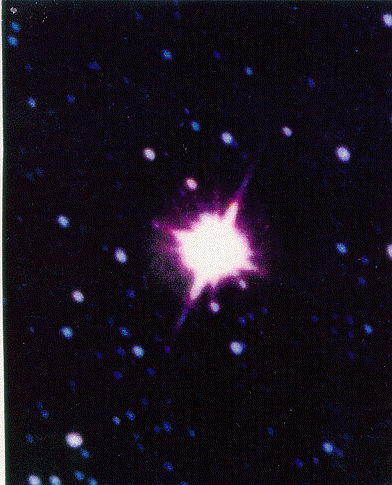 A
Neutron Star
A
Neutron Star
Neutron Stars and Pulsars : Sometimes the core remnant of a low-mass star is too dense to form a white dwarf. In these cases, the coreís stellar collapse forms a neutron star.
Neutron stars are incredibly dense spheres of degenerate neutrons (a gas in which all the allowed states for particles, electrons or neutrons, have been filled, thereby causing the gas to behave differently from ordinary gases). Some neutron stars have massive magnetic fields that sweep out beams of radiation into space, much like light beams from a lighthouse. Such ëpulsatingí neutron stars are called pulsars. This measurable ëpulseí of radiation is where this type of neutron star derives its name.
Astronomical models suggest that the properties of superconductivity and superfluity dominate the cores of neutrons stars. These models also suggest there is an upper l limit in the mass of neutron stars. These upper limits are in the range of the mass of the largest possible white dwarfs.
The Little Bang : The death of high-mass stars. This death of a low mass star into a white dwarf contrast with the final stages of high-mass, main sequence stars (i.e., greater than four solar masses). Unlike low mass stars, high mass stars can extend their lives through the fusion of elements heavier than carbon.
After the fusion of helium ends, high mass stars begin burning carbon as their next fuel consumption stage. Carbon burning begins when the star's core reaches temperatures greater than 600 million degrees Kelvin. The greater the mass of the original main sequence star the longer the star continues to burn heavier elements. Incredibly massive stars continue fusion from helium until they create iron (Fe) in their core.
In this fusion process, these massive stars create neon (Ne), magnesium (Mg), oxygen (O), sulfur (S), silicon (Si) and finally iron (Fe). Each stage of fuel consumption parallels a raise in the starís core temperature. Neon fusion begins when the starís core temperature reaches one billion degrees Kelvin followed by oxygen at 1.5 billion degrees Kelvin. Silicon fusion does not begin until the starís core temperature reaches an amazing 3 billion degrees Kelvin.
As the star begins each new fuel consumption stage, its lifetime in each stage becomes shorter. The following table illustrates the amount of time an aging star spends in each fuel consumption stage.
 A
H-R diagram (The red line represents the Main Sequence stars and their
evolution toward the top right hand corner of the diagram).
A
H-R diagram (The red line represents the Main Sequence stars and their
evolution toward the top right hand corner of the diagram).
These massive stars continue to exist by burning the heavier nuclides (magnesium, silicon, phosphorous et al) until they reach the heaviest nuclide that fusion can produce, iron. The iron rich cores of these massive stars can reach sizes equivalent to the Earth. The size of the surrounding shells burning the various lighter elements (H, He, C, O) dwarf this iron core, as they reach sizes that would extend to the orbit of Jupiter.
When the core of a high-mass star consists completely of iron, fusion can no longer take place. At this point, the mass of the daughter (one iron nuclide) is heavier than the total mass of the parent nuclides used to produce iron. With this difference in mass, the process begins to absorb energy instead of releasing it back into the star, whichunbalances thethermal equilibrium of the star.
With fusion ceased and the thermal equilibrium unbalanced, a starís only source of energy is from the contraction of the starís outer layers. This contraction raises the starís core temperature to 5 billion Kelvin and increases the pressure to the point that the iron core collapses upon itself.
The incredible pressures that the collapse of the starís iron core force many of the existing (but not all) protons and electrons to combine into neutrons. For a moment the star releases this abundance of neutrons as neutrinos. In this brief escape, many neutrinos bombard the iron core and combine with iron nuclides to form the elements heavier than iron. These escaping neutrinos and the electromagnetic forces that repel protons and neutrons force the star into a final expansion.
A Starís Eulogy, a Supernova. This final expansion sends a shock wave through the starís outer layers until it reaches the starís surface creating a supernova. This shock wave ejects all the material of the star, including the core into the cosmos leaving behind only a nebula of cooling gasses.
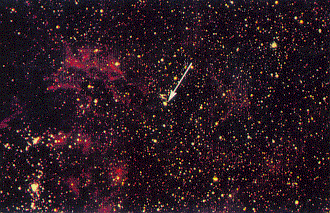 A
section of space before the supernova
A
section of space before the supernova
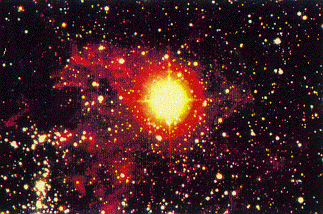 The
same section of space after the supernova
The
same section of space after the supernova
Stars too big for their britches : Black Holes. Sometimes high-mass stars are too massive to become white dwarfs or neutron stars. A high-mass star this massive also has the gravitational forces to prevent the escape of stellar matter through a supernova. Stars with this great of mass become black holes at the end of their stellar evolution.
Black holes are the result of the overpowering weight of the starís massive outer layers pressing inward from all sides on the core causing the rapid contraction of the dying star. With this great mass pressing inward, the starís core can no longer support the starís outer layer structure.
The matter within a high-mass star in this process is so condensed that the gravity produced is strong enough to prevent the escape of light energy from the cooling radioactive material. Light cannot escape because the escape velocity at the starís surface is greater than that of the speed of light.
Gravity of this magnitude has profound effects upon the starís shape and on the structure of the surrounding space. With the star collapsing in upon itself, the star changes from a spherical shape to a broader plane in space. The gravity from the center of this plane curves its surrounding space to create a whirlpool-like drain that absorbs the star itself and all surrounding matter.
 An
Artist rendition of a black hole event horizon (notice the whirlpool like
shape that leads to the blackhole's singularity).
An
Artist rendition of a black hole event horizon (notice the whirlpool like
shape that leads to the blackhole's singularity).
This plane at the mouth of the whirlpool-like drain is called an event horizon. The immense gravitational forces of the black hole compacts all the matter within the star after it moves past the event horizon of the newly formed black hole. The gravity of the black hole compresses the starís matter, as well as any other matter captured by the black holeís gravitational forces through its existence, to infinite density. This infinitely dense matter within the black hole is called a singularity. The gravitational pull of a singularity is so great that it pulls matter from all surrounding areas into the event horizon of the black hole.
If light cannot escape black holes, how do we find them? Until recently black holes were only theoretical speculations, but with todayís technology we are now finding black holes by measuring x-ray emissions in space.
As the black holes immense gravity captures surrounding matter, this matter accelerates toward the event horizon and singularity and releases high amounts of x-rays. These x-rays leave a trail through space as the black hole absorbs the matter into its singularity. X-ray trails leave ëhalosí around the black hole called accretion disks.
Another method of detecting black holes in space is their effects on binary star systems. When a black hole occurs close to two stars, its gravity impacts their spatial relationships. Each starís gravity has a calculable effect upon the otherís orbit, however the invisible black hole affects these orbits.
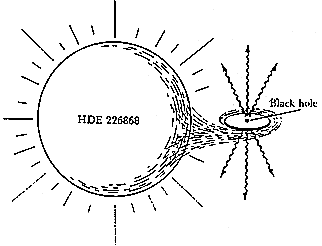 An
Artist rendition of a blackhole syphoning plasma gas from a nearby star
(this acceleration of matter emits x-rays that form a accretion disk and
make the blackhole detectable [x-ray emissions represented by the arrows]).
An
Artist rendition of a blackhole syphoning plasma gas from a nearby star
(this acceleration of matter emits x-rays that form a accretion disk and
make the blackhole detectable [x-ray emissions represented by the arrows]).
To contrast the idea of black holes being places in the universe with infinite lifetimes where no matter (including light) ever escapes, the universe holds a few exceptions. The British physicist Stephen W. Hawking has proven that black holes do in fact have definite lifetimes.
As black holes reach the end of their life, they begin to evaporate. In the final stages of this evaporation, the black hole reverses itself and pours matter back out into the universe. When a black hole begins to eject its matter, it is a white hole. With this transformation in the life of a black hole, the universe appears to maintain the fundamental universal energy-matter law with this process. While the black hole, to physics' laws, is an unbalancing factor in universal laws, the white hole exists to restore this matter and balance.
Our Two-cents--Please, no change
Stellar evolution is the necessary fundamental building block and distributive method of most common elements in the universe. Within the interior of stars, fusion creates new elements from the basic elements (H, He). While this process takes billions of years as measured by human standards, the life of a star is minor in comparison to the age of the universe.
Much like its life span, the outcome of one starís life is insignificant.
When we add the efforts of one star, however, to the production of the
billions of stars that have existed, exist and will exist again they are
invaluable to the creation of life. Without the elements produced by stellar
evolution (the processes within the interiors of stars), Carbon-based life
as we know it would not be possible. The next time you are star gazing,
remember, you are a product of the stars.
Reference
1. Universe (fourth edition). Kaufmann, William J. III. W. H.
Freeman and Company New York, 1994.
2. http://www.astro.washington.edu/strobel/evolution.notes/evolutio
n.notes.html
Glossary of bold face items
absolute zero - Temperature of -273 degrees Celsius where all molecular
motion stops; the lowest possible temperature
accretion disk - A disk of gas orbiting a star or black hole
binary star system - Two stars revolving around each other
black hole - An object that is so strong that its escape velocity exceeds
the speed of light
core helium burning - The thermonuclear fusion of helium at the center
of a star
degenerate - The phenomenon, due to quantum mechanical effects, whereby
the pressure exerted by a gas does not depend on its temperature
event horizon - The location around a black hole where the escape velocity
equals the speed of light; the surface of a black hole
fusion - combination of lower mass nuclides into higher mass nuclides
helium flash - The nearly explosive beginning of helium burning in the
dense core of a red giant star
hydrostatic equilibrium - The balance between the weight of a layer
in a star and the pressure that supports it
luminosity - The rate at which electromagnetic radiation is emitted
from a star or other object
main sequence star - A star whose luminosity and surface temperature
place it on the main sequence on an H-R diagram; a star that derives its
energy from core hydrogen burning
mass- luminosity relation - The relationship between the masses and
luminosities of main sequence stars
neutrino - A subatomic particle with no electric charge and little or
no mass, yet one that is important in many nuclear reactions
neutron star - A very compact, dense star composed entirely of neutrons
planetary nebula - A luminous shell of gas ejected from an old, low-
mass star
plasma - A hot ionized gas
pulsar - A pulsating radio source believed to be associated with a rapidly
rotating neutron star
red giant - A large, cool star of high luminosity
red supergiant - An extremely large, cool star of luminosity class I
shell helium burning - The thermonuclear fusion of helium in a shell
surrounding a starís core
shell hydrogen burning - The thermonuclear fusion of hydrogen in a shell
surrounding a starís core
singularity - A place of infinite space-time curvature; the center of
a black hole
solar mass - The mass of our sun; reference point for the masses of
other stars
solar radii - The distance from a starís core to the surface of its
outermost plasma layer
spectral type - A classification of stars according to the appearance
of their spectra
supernova - A stellar outburst during which a star suddenly increases
its brightness roughly a millionfold
thermal equilibrium - The balance between the input and outflow of heat
in a system
thermal pulse - Brief bursts of energy output from the helium- burning
shell of an aging low-mass star
thermal radiation - The radiation naturally emitted by any object that
is not at absolute zero
thermonuclear reaction - A reaction resulting from the high speed collision
of nuclear particles that are moving rapidly because they are at a high
temperature
white dwarf - A low-mass star that has exhausted all of its thermonuclear
fuel and contracted to a size roughly equal to the size of Earth
white hole - A black hole from which matter and radiation emerge
X-Ray - Electromagnetic radiation whose wavelength is between that of ultraviolet light and gamma rays